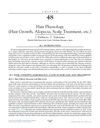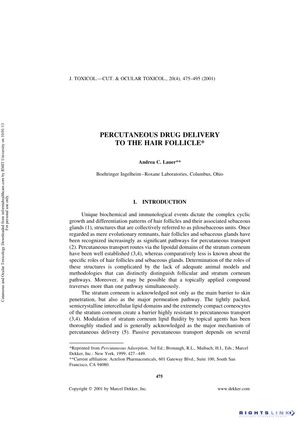TLDR Hair follicles could be used to deliver drugs effectively, with the right understanding and methods.
The 2001 document examines the role of hair follicles and sebaceous glands in percutaneous drug delivery, highlighting their potential as channels and reservoirs for various compounds. It discusses the limitations and usefulness of animal models, particularly hairless rodents, in studying follicular drug delivery and notes that hairless rat skin allows for greater systemic accumulation of certain molecules. The document also reviews methodologies for assessing follicular permeation and concludes that while no perfect animal model exists, these methods offer the best hope for understanding drug delivery pathways to the hair follicle. Studies mentioned include one with 45 young rats where a liposomal anti-doxorubicin monoclonal antibody prevented alopecia in 31 rats, and another using hamster ear models to assess follicular delivery of [³H]cimetidine. The potential of liposomes and polymeric microspheres for enhancing drug delivery to hair follicles is emphasized, with specific particle sizes and formulations being more effective for targeting. The document suggests that a better understanding of hair follicle and sebaceous gland anatomy could improve targeted drug delivery for conditions like acne, male-pattern baldness, and alopecia areata.
37 citations
,
January 1997 in “Journal of Pharmaceutical Sciences” Hairless rats absorb substances through their skin more easily than hairy rats.
57 citations
,
October 1996 in “Dermatologic clinics” HA-MNs with MXD effectively treat hair loss better than topical MXD with fewer side effects.
 34 citations
,
December 1991 in “Annals of the New York Academy of Sciences”
34 citations
,
December 1991 in “Annals of the New York Academy of Sciences” The conclusion is that small hair follicles cause baldness in macaques, and treatments like antiandrogens and minoxidil can prevent hair loss and promote regrowth.
 1 citations
,
January 2017 in “Elsevier eBooks”
1 citations
,
January 2017 in “Elsevier eBooks” The document concludes that new treatments for hair loss may involve a combination of cosmetics, clinical methods, and genetic approaches.
122 citations
,
March 2013 in “Expert opinion on drug delivery” Optimizing drug delivery to hair follicles is crucial for effective treatment.
 5 citations
,
September 2012 in “Springer eBooks”
5 citations
,
September 2012 in “Springer eBooks” Nanoparticles can be used to deliver drugs to hair follicles, potentially improving treatments for conditions like acne and alopecia, and could also be used for vaccine delivery and gene therapy.
 97 citations
,
September 2011 in “British Journal of Dermatology”
97 citations
,
September 2011 in “British Journal of Dermatology” The human hair follicle can store topical compounds and be targeted for drug delivery with minimal side effects.
142 citations
,
January 2010 in “Journal of dermatological science” Hair follicles are promising targets for delivering drugs effectively.
 109 citations
,
November 2005 in “The journal of investigative dermatology. Symposium proceedings/The Journal of investigative dermatology symposium proceedings”
109 citations
,
November 2005 in “The journal of investigative dermatology. Symposium proceedings/The Journal of investigative dermatology symposium proceedings” Targeting hair follicles can improve skin treatments and reduce side effects.
64 citations
,
April 2005 in “Journal of Investigative Dermatology” Topical oligonucleotide therapy targets hair follicles effectively.





